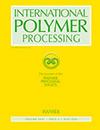Influence of process parameters of a continuous final mixer on the properties of carbon black/rubber composites
IF 1.9
4区 工程技术
Q4 ENGINEERING, CHEMICAL
引用次数: 0
Abstract
Abstract As the final stage of the mixing process, the final mixing has a profound impact on the properties of rubber compounds. The influence of the process parameters of a continuous final mixer on the properties of carbon black/rubber composites is studied. It is found that there are two factors affecting the performance of the composite: the rotating speed of the dual rotors and the temperature of the continuous final mixer. When the temperature is unchanged, the extruding temperature of the final-mixing rubber compound increases with increasing rotating speed, and the Mooney viscosity, T10, T90 and rolling resistance gradually decrease. The Payne effect decreases first and then increases, and the overall trend gradually decreases. When the rotating speed is constant, as the temperature of the continuous final mixer rises, the extruding temperature also rises, and the temperature difference between feeding and extruding increases. Mooney viscosity and tensile strength increase. The Payne effect is more significant. T10, T90 and rolling resistance gradually decrease. The M300 of a vulcanized sample shows the following laws: When the control temperature is low, the influence of rotational speed is small, the fluctuation range is small, and has a steady rising trend; however, when the temperature is higher, M300 fluctuates greatly under the influence of rotational speed. The optimal process parameters of the rubber continuous final mixer are determined: the double rotor speed is 30RPM, and the temperature control temperature is 60–70 °C.连续混炼工艺参数对炭黑/橡胶复合材料性能的影响
作为混炼过程的最后阶段,最终混炼对橡胶化合物的性能有着深远的影响。研究了连续混炼工艺参数对炭黑/橡胶复合材料性能的影响。研究发现,影响复合材料性能的因素有两个:双转子的转速和连续式终混合器的温度。在温度不变的情况下,终混胶料的挤出温度随着转速的增加而升高,穆尼粘度、T10、T90和滚动阻力逐渐降低。Payne效应先减小后增大,整体趋势逐渐减小。当转速一定时,随着连续式终混合器温度的升高,挤出温度也随之升高,进料与挤出之间的温差增大。穆尼粘度和抗拉强度增加。佩恩效应更为显著。T10、T90和滚动阻力逐渐减小。硫化试样的M300表现出以下规律:控制温度较低时,转速的影响较小,波动范围较小,且有稳定上升的趋势;当温度较高时,受转速影响,M300波动较大。确定了橡胶连续式终炼机的最佳工艺参数:双转子转速为30RPM,控温温度为60-70℃。
本文章由计算机程序翻译,如有差异,请以英文原文为准。
求助全文
约1分钟内获得全文
求助全文
来源期刊

International Polymer Processing
工程技术-高分子科学
CiteScore
2.20
自引率
7.70%
发文量
62
审稿时长
6 months
期刊介绍:
International Polymer Processing offers original research contributions, invited review papers and recent technological developments in processing thermoplastics, thermosets, elastomers and fibers as well as polymer reaction engineering. For more than 25 years International Polymer Processing, the journal of the Polymer Processing Society, provides strictly peer-reviewed, high-quality articles and rapid communications from the leading experts around the world.
 求助内容:
求助内容: 应助结果提醒方式:
应助结果提醒方式:


